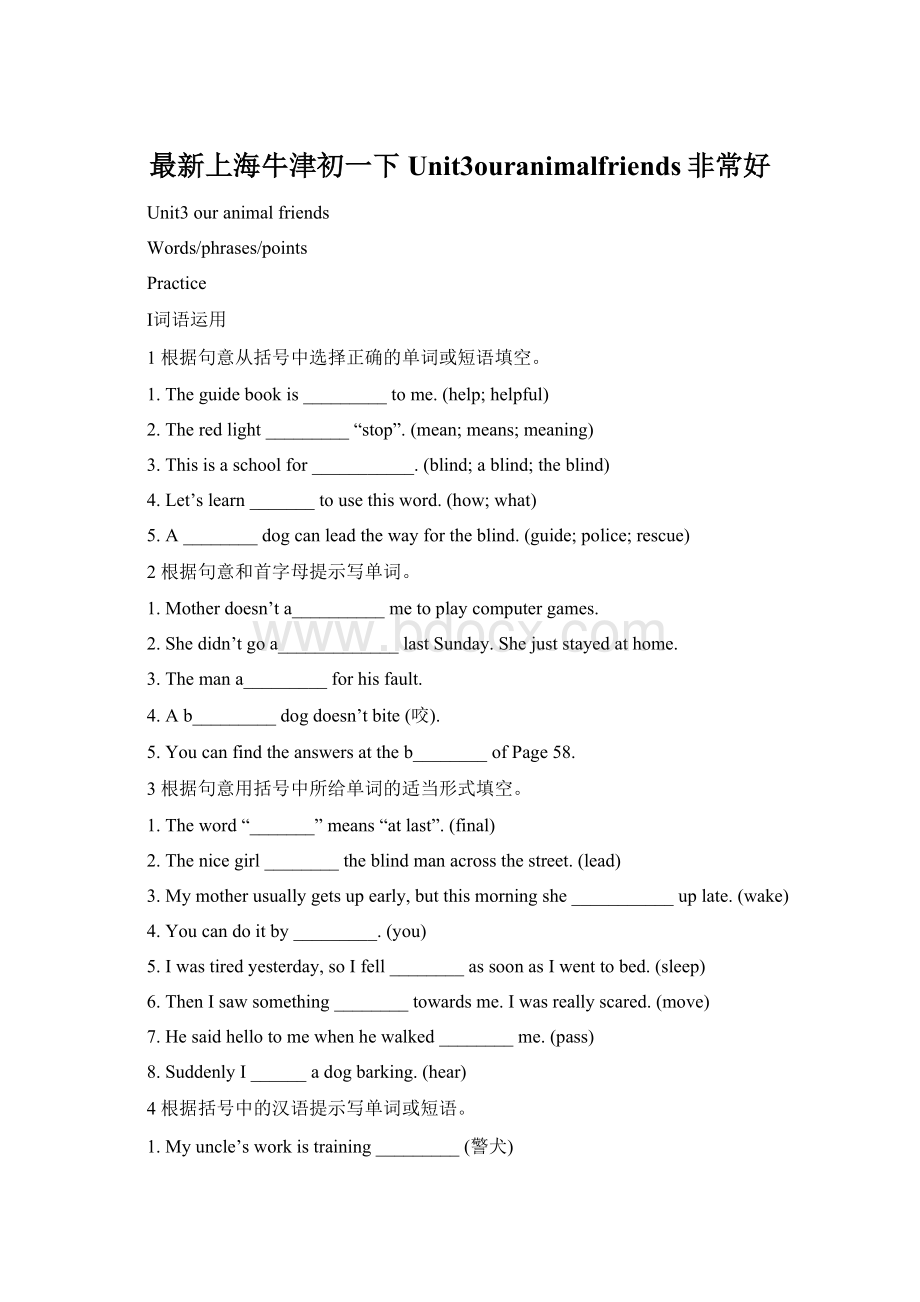最新上海牛津初一下Unit3ouranimalfriends非常好.docx
《最新上海牛津初一下Unit3ouranimalfriends非常好.docx》由会员分享,可在线阅读,更多相关《最新上海牛津初一下Unit3ouranimalfriends非常好.docx(10页珍藏版)》请在冰豆网上搜索。

最新上海牛津初一下Unit3ouranimalfriends非常好
Unit3ouranimalfriends
Words/phrases/points
Practice
Ⅰ词语运用
1根据句意从括号中选择正确的单词或短语填空。
1.Theguidebookis_________tome.(help;helpful)
2.Theredlight_________“stop”.(mean;means;meaning)
3.Thisisaschoolfor___________.(blind;ablind;theblind)
4.Let’slearn_______tousethisword.(how;what)
5.A________dogcanleadthewayfortheblind.(guide;police;rescue)
2根据句意和首字母提示写单词。
1.Motherdoesn’ta__________metoplaycomputergames.
2.Shedidn’tgoa_____________lastSunday.Shejuststayedathome.
3.Themana_________forhisfault.
4.Ab_________dogdoesn’tbite(咬).
5.Youcanfindtheanswersattheb________ofPage58.
3根据句意用括号中所给单词的适当形式填空。
1.Theword“_______”means“atlast”.(final)
2.Thenicegirl________theblindmanacrossthestreet.(lead)
3.Mymotherusuallygetsupearly,butthismorningshe___________uplate.(wake)
4.Youcandoitby_________.(you)
5.Iwastiredyesterday,soIfell________assoonasIwenttobed.(sleep)
6.ThenIsawsomething________towardsme.Iwasreallyscared.(move)
7.Hesaidhellotomewhenhewalked________me.(pass)
8.SuddenlyI______adogbarking.(hear)
4根据括号中的汉语提示写单词或短语。
1.Myuncle’sworkistraining_________(警犬)
2.Rescuedogscanhelpthepeoplein________(危险)
3.Taoxian___________(机场)isabout30kilometersawayfromthecentreofShenyang.
4.She________(上演)inherfirstfilmwhenshewas13yearsold.
5.Heisapopularactorandheoften__________(出现)onTV.
6.A__________(海豚)canplayaball.
7.Wesatonthe________(岩石)listeningtothesoundofwaves.
8.Iwastoo_______(恐惧的)tomove.
9.They_________(推)himintothecar.
10.She________(迈步)onmyfootandsaidsorrytome.
Ⅱ翻译短语
1.到达______________2.独自_________________
3.引领……到……_____________4.入睡__________________
5.醒来_______________6.蹲下_________________
7.邻近……_______________8.消防车_________________
Ⅲ语言运用
(A)同义句改写
1.SoonIwenttosleep.
SoonI____________________.
2.Finallytheyunderstandme.
_________________theyunderstandme.
3.CharliestartedbarkingandwokeupJohn.
Charliestarted__________________andwoke_________________.
4.Withafireman’shelp,Johngotoutofthebuilding.
Withthe_____________________a__________,John__________thebuilding.
5.Ican’tgoanywherebymyself.
I__________go__________bymyself.
(B)根据所给的汉语完成句子解释。
6.欢迎参观我校。
_________________________visitourschool.
7.我不允许你做那种事。
Idon’t_____________________that.
8.对不起,我不能和你一起去。
______________________Ican’tgowithyou.
9.我们将于明到达海南。
Wewill_______________Hainantomorrow.
10.我们可以带宠物去公园吗?
Canwe___________________________?
Ⅳ单项选择
1.Blindpeoplearehighlysensitiveto_____________.
A.colorsB.shapesC.hearingD.taste
2.Mrs.Liteaches_________English.Weareallinterestedin________lessons.
A.our;sheB.our;herC.us;sheD.us;her
3.Afewminutes________,shecamebackwithsomeflowersinherhands.
A.lateB.laterC.afterD.earlier
4.Thedog’sbarking__________.
A.wakesuphimB.wakehimupC.wokeuphimD.wokehimup
5.Thenheheardthe________ofafireengine.Itwasmusictohisears.
A.noiseB.voiceC.soundD.singing
6.Theguidebookwilltellyouhow________careoftheflowers.
A.takeB.takingC.takesD.totake
Gramer
第一组:
over,above和on的用法
1)over指在…的正上方,表示垂直在上。
如:
Thereisalampoverthedesk.
2)above指在上方,属于斜上方。
如:
Raiseyourarmsaboveyourhead.
3)on指在上面,表示两物体接触。
如:
Thereisacuponthetable.
第二组:
under/below的用法:
1)under在……下面/正下方:
What'sunderyourdesk?
2)below在……斜下方:
Herskirtcamebelowherknees.
练习:
()1Theboatispassing___thebridge.
A.through B.below C.under D.across
()2Twoplanesareflying___thecity.
A.through B.over, C.on, D,below
()3Wecanseeariverrunningtotheeast____thehill.
A.under B.below C.over D.on
()4Doyouseethekite___thebuilding.
A.over B.cross C.on D.above
第三组:
in和on表示“在……上”
1,门一类——镶嵌在墙里的,用in,
字画一类——挂在墙面上的,用on
()1Heputupamap___thebackwallbecausetherewasahole___it.
A.on;onB.at;inC.on;inD.on;at
()2Thereisadoor___thewall.
A.onB.toC.ofD.in
()3Anyman___eyes______hisheadcanseethathe'sexactlylikearope.
A.with;onB.with;inC.on;withD.in;with
2,鸟一类落在树上的,用in;
苹果一类长在树上的,用on
()1Therearesomebirdssinging___thetrees.
A.inB.onC.atD.from
()2Therearesomanyapples___thattree.
A.inB,onC.atD.from
第四组:
in/on/to表示“接壤”
BABABA
B在A里——用inA和B相邻(接壤)——用onA和B不相邻(不接壤)——用to
()1TheUnitedStatesis____thesouthofCanadaand___theeastofJapan.
A.to;in B.on;to C.in;beside D.at;on
()2Themanstood____thewindow,watchingtheboysplayingoutside.
A.in B.by C.with D.to
()3Japanlies____theeastofChina.
A.on B/to C.in D.with
第五组:
at,in表示“在……”
1)at表示较小的地点。
如:
atthebusstop,athome
2)in表示较大的地点。
如:
inChina,intheworld
()1UncleWangarrived____No.14MiddleSchoolhalfanhourago.
A.atB.inCtoD./
()2Myunclelives____88BeijingStreet.
A.toB.ofC.atD.on
()3Theyarewaiting___abus___thebusstop.
A.for;inB.on;atC.with;atD.for;at
第六组:
infrontof和inthefrontof
1)infrontof表示“在…之前”(范围外)。
如:
Therearesometreesinfrontoftheclassroom.
2)inthefrontof表示“在…的前部”(范围内)
如:
Thereisablackboardinthefrontoftheclassroom.
第七组:
in/into
in表示“在……里面”,强调静态;
into表示“去……里面”,强调动态。
第八组:
through/across通过,穿过
across表示横过,即从物体表面通过,与on有关,为二维
through穿过,即从物体内部穿过,与in有关,为三维。
练习
()1Isthestreettoonarrowforthebustogo___?
A.through B.across C.on D.in
()2Amothercamelwaswalking___herson___thedesert.
A.without;along B.with;through
C.nextto;pass D.beside;through
()3Theriverruns____thecity.
A.across B.through C.over D.from
()4Ittookusoveranhourtowalk____thisstreet.
A.from B.through C.over D.across
练习1:
1.Tomsits____theclassroomwhileJohnsits____theroom.
A.infrontof;atbackof B.inthefrontof;atthebackof
C.infrontof;atthebackof D.inthefrontof;atbackof
2.Lucysits____thethirdrow,____Jim‘sleft.
A.on;on B.in;at C.at;in D.in;on
3.Jiangsuis___theeastofChina,butJapanis___theeastofChina.
A.to;in B.in;to. C.on;to D.to;on
4.Don‘tread____thesun.It‘sbad___youreyes.
A.in;to B.under;for C.with;to D.in;on
5.Thewoman____abluedressismyteacher.
A.in B.on C.of D.at
6.___research___theuniverse,scientistshaveputalotofinformation___computers.
A.With;over;at B.On;at;toC.In;about;into D.For;with;through
7.Whenapieceoficeistaken____awarmroom,itgetssmallerandsmalleruntil___theenditdisappearscompletely.A.in;in B.outof;at C.into;in D.to;by
8.Awomanfell___theboat___thewater.
A.off;into B.at;below C.down;under D.away;in
Homework
Ⅴ阅读训练
(A)
(B)
(C)
调研结论:
综上分析,我们认为在学院内开发“DIY手工艺品”商店这一创业项目是完全可行的。
(D)
(二)大学生对DIY手工艺品消费态度分析
综上所述,DIY手工艺品市场致所以受到认可、欢迎的原因就在于此。
我们认为:
这一市场的消费需求的容量是极大的,具有很大的发展潜力,我们的这一创业项目具有成功的前提。
成功秘诀:
好市口+个性经营
2003年,上海市人均GDP按户籍人口计算就达到46700元,是1995年的2.5倍;居民家庭人均月可支配收入为14867元,是1995年的2.1倍。
收入不断增加的同时,居民的消费支出也在增加。
2003年上海居民人均消费支出为11040元,其中服务性消费支出为3369元,是1995年的3.6倍。
Ⅵ书面表达
在调查中我们注意到大多数同学都比较注重工艺品的价格,点面氛围及服务。
请以“Myfavoriteanimalis_______”为题写一篇60词左右的短文。
2003年,上海市人均GDP按户籍人口计算就达到46700元,是1995年的2.5倍;居民家庭人均月可支配收入为14867元,是1995年的2.1倍。
收入不断增加的同时,居民的消费支出也在增加。
2003年上海居民人均消费支出为11040元,其中服务性消费支出为3369元,是1995年的3.6倍。
要求:
1.补全标题。
2.
3.为此,装潢美观,亮丽,富有个性化的店面环境,能引起消费者的注意,从而刺激顾客的消费欲望。
这些问题在今后经营中我们将慎重考虑的。
描写外貌、特点。
4.举例说明喜欢的理由。
300-400元1632%Myfavoriteanimalis_______________
一、消费者分析
_______________________________________________________________________________________________________________________________________________________________________________________________________________________________________________________________________________________________________________________________________________________________________________________________________________________________________________________________________________________________________________________________